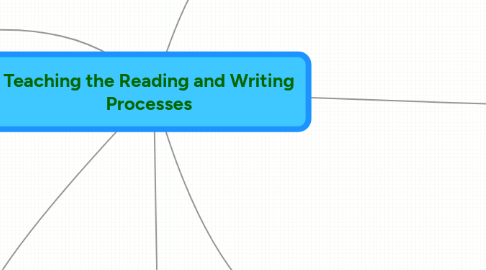
1. Writing Strategies and Skills
1.1. Prewriting strategies
1.1.1. generating & organizing ideas
1.2. Drafting Strategies
1.2.1. narrowing the topic and providing answers
1.3. Revising Strategies
1.3.1. rereading, detecting problems, elaborating ideas
1.4. Publishing Strategies
1.4.1. designing the layout and reading expressively
1.5. Content Skills
1.5.1. applying skills to arrange information in paragraphs.
1.6. Word Skills
1.6.1. applying skills during drafting and revising to make their writing clearer.
1.7. Sentence Skills
1.7.1. applying skills to make their writing more interesting to read.
1.8. Grammar Skills
1.8.1. using skills to correct any nonstandard English errors during writing.
1.9. Mechanical Skills
1.9.1. applying spelling, capitilization, and punctuation skills during the editing stage.
2. Assessing Students' writing
2.1. Teachers use rubrics, or scoring guides, to assess the quality of a student's work.
3. The Reading Process
3.1. PhonemicAwareness: Students use their knowledge about the honological system as they read.
3.2. Word Identification: recognition of high frequency words automatically. Students use their knowledge of phonics and word parts to decode unfamiliar words.
3.3. Fluency: When students recognize words automatically and read quickly with expression.
3.4. Vocabulary: Students think about the meaning of the words their reading and relate them to background knowledge.
3.5. Comprehension: Using a combo of reader and text factors to understand what they are reading.
3.6. Stages of the Reading Process
3.6.1. Stage 1: Pre-reading
3.6.1.1. activating or building background knowledge.
3.6.2. Stage 2: Readng
3.6.2.1. applying reading strategies or skills
3.6.3. Stage 3: Responding
3.6.3.1. writing in reading logs, or participating in conversations or discussions.
3.6.4. Stage 4:Explorng
3.6.4.1. learning new vocab., participating in minilessons
3.6.5. Stage 5: Applying
3.6.5.1. construct projects
4. The Writing Process
4.1. Stages of the writing process
4.1.1. Stage 1 Prewritng
4.1.1.1. considering the purpose fro writing/what is the topic?
4.1.2. Stage 2:Drafting
4.1.2.1. writing a rough draft
4.1.3. Stage 3: Revising
4.1.3.1. rereading the rough draft, making substantive changes
4.1.4. Stage 4:Editing
4.1.4.1. proofreading the revised rough draft
4.1.5. Stage 5:Publishing
4.1.5.1. making a final copy
5. Qualities of Good Writing
5.1. Ideas
5.1.1. choosing an idea and then developing it using main ideas and details.
5.2. Organization
5.2.1. presenting their ideas logically and ending with a satisfying conclusion.
5.3. Voice
5.3.1. What a writer breathes into their piece of writing.
5.4. Word Choice
5.4.1. careful word choices make the meaning clear and the composition easier to read.
5.5. Sentence Fluency
5.5.1. The rhythm and flow of language
5.6. Mechanics
5.6.1. spelling, capitalization, and grammar.
6. Classroom Connections
6.1. Some guidelines for connecting reading and writing so that students have a clearer understanding are:
6.1.1. Involve students in daily reading and writing experiences
6.1.2. Introduce reading and writing processes in Kindergarten
6.1.3. Plan instruction that reflects the developmental nature of reading and writing.
6.1.4. Make a reading-writing connection explicit to students
6.1.5. emphasize both the processes and the products of reading and writing.
6.1.6. Set clear purposes for reading and writing
6.1.7. Teach reading and writing through authentic literary experiences.
